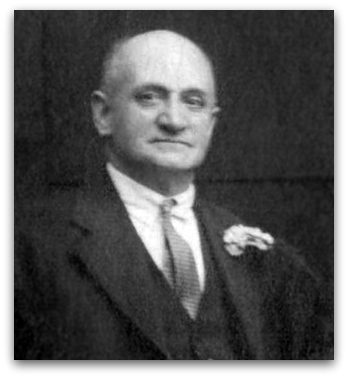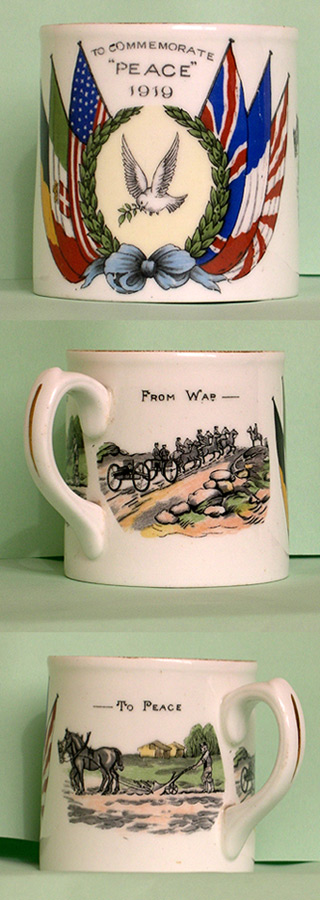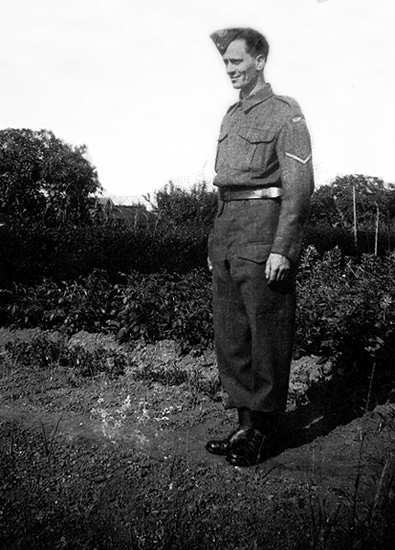Farms
Mapperley Farm, situated on Main St was run by Mr Hill, a rather remote man, and ‘Big’ Henry, his nephew. ‘Little’ Henry the son was a farm contractor. As with the other farms dairy cattle were kept along with pigs and poultry and they grew quite a wide variety of crops. Most people bought their milk from the farm, collecting it twice a day at milking time. The milk would be cooled by running it over a cooler which was like a vertical wash board, but with cold water running through, and ladled out by Molly the daughter. It was collected in ‘cans’, usually galvanised pint or quart size with a handle. We discovered centrifugal force; in that if we swung the can in a vertical circle at arms length; the milk would stay in the can. I also discovered that if the can stopped at the top the milk would pour out. Once while I was swinging my grandmother’s posh enamelled can it caught the ladder bar on the rather short street lamp, gas in those days, at the bottom of Ma’s garden. The results were a dent and cracked enamel in the can, a soaking in milk for me and my having to face my grandparents and then my mother.
At threshing time the stack would be surrounded with wire netting and the boys would kill the rats which ran out as the stack went down with stout sticks. Most if the rats would retreat down the stack as it went down and so as the last few layers of sheaves were lifted the rats came out thick and fast.
The threshing set: Threshing machine (drum), chaff cutter and baler were belt driven by a tractor. At first only Hill’s and the farm contractors had a tractor, the other farms using horses for ploughing, carting etc. Just before my time Hills used a steam engine to power the threshing machinery, I am sure that I saw it used at least once. There were two engines at the back of the yard both with a large horizontal wheel under the boiler which could be used to pull a plough between them across the field.
Before the advent of combine harvesters, pick-up bailers, and silage corn would be cut using a binder and the sheaves leaned together in stooks to dry before taking them on a ‘dray’, a flat cart with a tall gate like structure at each end, to be stacked and hay would be dried lying in the field and turning before being gathered into haycocks and then loaded onto a dray and stacked. The loading being done with hayforks and the work getting harder as the load got higher especially on a hot day.
At the end of the war two German P.O.Ws came to help with the threshing, guarded by two very bored looking British soldiers. Italian P.O.Ws were allowed to live and work on the farms unguarded, although I only know of one locally. I believe Germans did so later but I don’t think any did so on the nearby farms.
When a calf was born they would sell ‘beastings’ i.e. colostrum which made the best egg custards and they would also sell large hard pears from a very large tree, which were ‘smothered’ in clothes drawers until soft.
Tractors replaced horses soon after the end of W.W.II and Hill’s three lived out their lives in the meadow. The last one to survive, a smallish chestnut named Punch was quite a favourite in the village and seemed quite happy with cows for company.
Reg. Udall kept Manor Farm, round the pool. He farmed similar things to the other local farms. At one time Mrs Udall had a small chip shop fryer and used to sell fish and chips a few nights a week which proved very popular.
Bridge Farm on Mapperley was farmed by Mr Lewis and later his son Noel.
People
I feel that there are a few people, who deserve a mention in these memories and who wouldn’t otherwise get one. So as they say “In no particular order” here goes:
Uncle Ged lived in the house on the left as you face up the twitchell. He used to be the village barber, cutting hair in his kitchen. His preferred cut for boys was short all over with a fringe. He believed that cutting hair short prevented baldness in later life and would say “yole thank may fu this” I used to have a short back and sides with a parting so maybe my ‘eggshell blonde’ state could have been prevented! One thing we hated was that he would blow bits of hair away with a spray of strongly tobacco smelling saliva. When his wife, Hannah bought him a cup of tea he would sometimes shout “Hannah yo anna storred my tay”
His front garden was overrun with London’s Pride and if you stripped the back off a leaf and stretched between your thumbs, held side by side, you could blow and make a whistling noise, as you can do with a wide blade of grass.
After uncle Ged died Harold ‘Lal’ Wood used to cut hair, a much more pleasant experience as he used to cut on Sunday Mornings, also in his kitchen, to the smell of the Sunday joint cooking
‘Teddy’ Thomas lodged with Uncle Ged. He was very short and in Mapperley the double 2 of dominoes was known as ‘Teddy Thomas’ because that was about the height of his eyes above the ground. This was said without malice. After Uncle Ged and Hannah died Teddy lived in a small caravan with a small kitchen attached and situated next to the Institute at the top of the field. After a long time the council decided that he shouldn’t be there. There was a lot of support for him in the village and eventually a large group of council officials, locals and George Brown our M.P. (Deputy to Harold Wilson) gathered looking towards the caravan across the field from the end of Coachways. George Brown solved the problem by suggesting that the caravan should be repainted to green to fit in with the surroundings. This was agreed and quickly done and Teddy lived his life out there.
Gordon Durow, who married the vicar’s daughter, Muriel Vaughan, was an excellent goal keeper and played for Mapperley Miners’ Welfare F.C. for many years and took a large part in running it for many more.
Charles Amos Martin 28th July 1881- 6th March 1954. He was known as Amos, was a strong minded character. He was my grandfather and I was always a little afraid of him. As a child I seemed prone to getting splinters which turned septic. His treatment was to get the kettle boiling, cut a small piece of lint which he held with the scissors, dipped it in the boiling water and then put it on the splinter. Strangely enough I never got scolded and the infection was cured and the splinter removed.

Charles Amos Martin |
Despite being 33 years old with 3 children of 5 and under he enrolled in the army 16 days after World War I broke out.
He was a stretcher bearer in the R.A.M.C. and was often under fire, rescuing the wounded from 'no man's land’. He was awarded the Military Medal, published in the London Gazette Supplement of January 28th 1918. The records of his service were lost in the blitz, but he was returned to civilian life in July 1918 on the Army Reserve as a result of being gassed. He was finally discharged from the army in January 1919. |
He was awarded the
Military Medal
|
|
He never fully recovered from the effects of the gas and was only able to leave the house in the summer during his last years. He would sit in the doorway of his house and talk to people and on rare occasions he would walk to the railings at the top of Lodge Road, and stand with his arms hooked in them for a short while to have a chat. Having barely survived his last few winters he eventually died in March 1954.
Wartime
As a 7 year old at the end of the war these memories are fairly limited, but some are clearly held. Two things I do remember were seeing a British fighter plane which had crash landed and skidded across a field near Park Hall. The pilot was standing waiting for collection and despite the plane being guarded by a policeman I got a small piece of the plane as a souvenir. The other was being taken to see two bomb craters in a field between the old pit railway line and Blue Fly.
I remember collecting hips and haws for vitamin C drink manufacture and also scrap metal. The school was issued with stirrup pumps which I remember being used to wash the windows down while practising with them. We were issued with, and had to carry, gas masks during part of the war. I also found another use for mine as told in the School Section.
Rationing was a fact of life, which parents coped with and most gave their children more than their fair share. If you knew where to look and take the risk of being caught; extra food could sometimes be obtained on the ‘Black Market’.
Clothes rationing meant that you only had working clothes, none working clothes in the week and a “best set” children often getting new clothes for Easter. In the interests of efficiency; clothes and many items furniture were standardised and made to government specifications and marked with the ‘Utility’ Mark. The mark was CC41, 1941 being the year that the scheme was brought out and CC indicating Civilian Clothing. The ‘Cs’ were like Packman figures and the 41 fitted into the last ‘C’.
I do remember rationing as it lasted long after the war. When we heard that ‘chewing wood’ (liquorice root) was in stock we would walk to a shop near to the Newdigate arms to buy some as a very welcome substitute for sweets The most memorable thing for me was the end of sweet rationing and being able to go into a shop and buy sweets limited only by what you could afford. Sweets did go back on ration for a short time.
During the war and during the years of food rationing especially, in season jam would be made and fruit bottled. Runner beans would be preserved by salting and apple rings threaded on a garden cane hung from a beam to dry and keep. The first field on the right of Slack Lane was given over to allotments and I remember tumps being made to store potatoes.
There was a street party with fancy dress for either V.E or V.J. day which was held at the school end of the Pool; and was amazed how much food was found from somewhere; private hoards, obviously. Perhaps someone has photos that they could submit. |
 This mug belonged to my family
This mug belonged to my family |
Home Guard
I vaguely remember the Home Guard, set up early in the war as a last ditch organisation to fight against any German invasion, which was expected any day at one time.
It was made up of civilians who trained after work. It was disbanded before the end of the war when the danger was judged to have passed. It is most famously remembered in “Dads’ Army”, still being broadcast on Saturday evenings. I do remember my father C. R. ‘Ron’ Martin (seen in his uniform here, I think on the allotments) who joined and at one time had a SMLE, 0.303 service rifle at home and which was kept strictly out of sight in the cupboard under the stairs. I don’t know if he had any ammunition at home, probably not. Even more exciting I remember my uncle Joe Martin “dry firing” a Bren gun on his yard and feeling jealous for my father ‘only’ having a rifle. Someone else had a ‘Tommy’ gun. I bet the Germans were relieved that they didn’t reach Mapperley!

|
 C. R. ‘Ron’ Martin
C. R. ‘Ron’ Martin |
Cars - Reasons for the lack of cars seen in the village, apart from people not being able to afford them, was the fact that few were made, factories making tanks aeroplanes and other items for the ‘War Effort’. Petrol rationing was also very strict.
War impinged less on the village than lots of areas; we did have for a spell when there were evacuees in the village. They were from either Coventry or Croydon and were due to arrive one evening, but arrived much later than expected and were met in the school with refreshments. Next morning, on arriving at the school we were given the left over egg sandwiches to finish up, which was regarded as a great treat. Arrangements had been made to accommodate the children, but some mothers also turned up which caused problems with allotting accommodation late at night. I remember my grandparents had a Mum and two children to stay; however I believe the adults soon returned. Apart from the egg sandwiches I can barely remember anything about the evacuees I’m afraid.
|